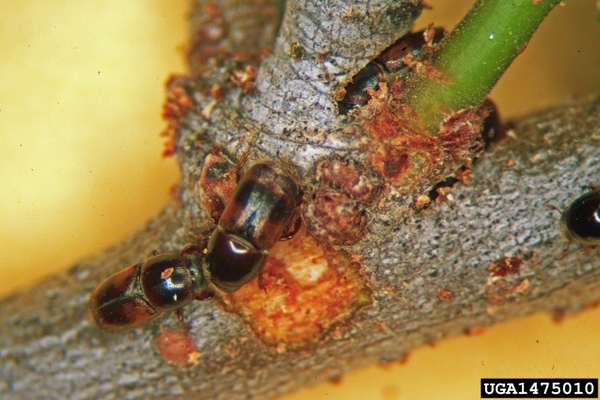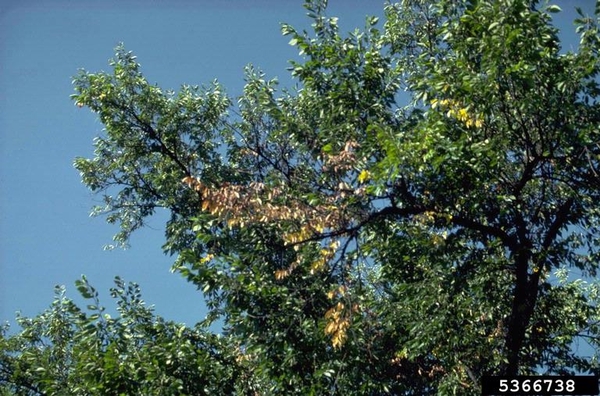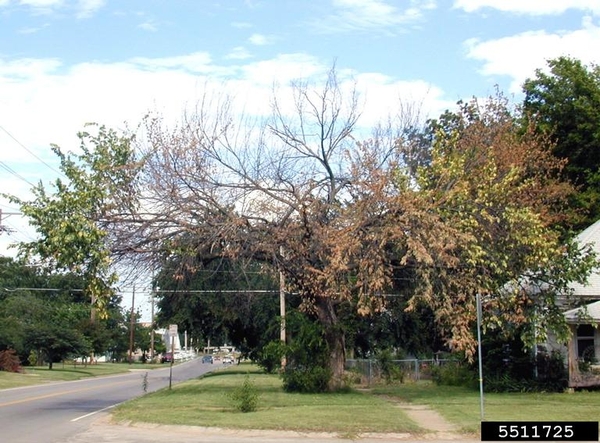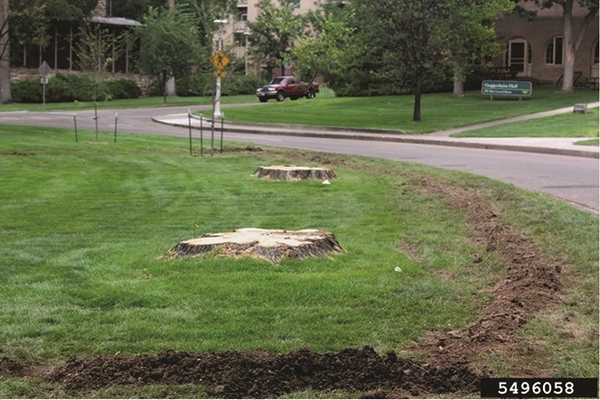Introduction
Dutch elm disease (DED) is a fungal disease that affects the vascular system of elm trees and causes crown dieback and tree mortality. The disease occurs when the fungus (Ophiostoma ulmi or Ophiostoma novo-ulmi) is introduced to elm trees by elm bark beetles or systemically through below-ground root fusions between two trees (called root grafts) with an infected elm. In a defensive response to the presence of the fungus, the infected tree seals off the xylem, blocking the transport of water within the tree causing it to wilt and die.
Dutch elm disease was introduced to North America in the 1930’s and to North Carolina in 1962. Prior to a nationwide outbreak in the 1970’s, elm trees were a dominant species in American forests and were the most commonly planted street tree in the U.S. Since its introduction in North America, DED has killed over 100 million elms. The exact native range of the fungus is unknown. However, because all Asian elms are resistant to the fungal disease to some degree, many believe it originates from Asia.
Hosts
All species of elm (Ulmus spp.) that are native to North America and Europe are susceptible to DED. American elm (Ulmus americana) is particularly susceptible to the disease.
Disease Cycle and Damage
Adult elm bark beetles are attracted to dead and dying elm trees where they will feed, mate, and lay eggs. The bark beetles carry fungal spores from one tree to another on their body and in their mouthparts. As the beetles exit an infected host tree, move to a new tree, and begin feeding, they introduce the fungus to the new host. The fungus can also spread from tree to tree via root grafts. Because the fungus infects the vascular tissue responsible for moving water and nutrients within the tree, infected branches wilt due to a lack of water being transported through the tissue. The fungus spreads throughout the vascular tissues of the tree and into the roots, eventually killing the tree. Infested trees can die within a year, though not every tree will die that quickly as the health of the tree and level of infestation can play a role.
Signs and Symptoms
When a branch is infected, the leaves wilt and turn brown and the branch dies, a condition known as flagging. As the fungus spreads, the wilting symptoms spread down the branch in the direction of the trunk, to the other branches, and through the canopy. The fungus causes dark brown streaking in the sapwood, which can be seen if the bark is removed. Symptoms are typically present from late spring to early fall.
Management
The most effective management tool for a tree infected with DED is removal and trenching to separate any root grafts with neighboring trees. While this does not save the infested tree, it can reduce the chances that other trees become infected. Fungicides with active ingredients thiabendazole and propiconazole can also be used preventatively. To best protect the tree, fungicides need to be reapplied every 1 to 3 years. When an infection is caught early, pruning the infected branches can also prevent the spread of the disease. Branches need to be pruned 8 to 10 feet beneath the lowest stain in the sapwood for the treatment to be effective. As a preventative measure, dead and dying elms should be removed to prevent attracting elm bark beetles to a site. Once a tree is removed, the wood should be destroyed immediately or stored in plastic sheeting for at least a year. Additionally, elm firewood should not be moved and should only be burned locally after being cut to prevent the spread of elm bark beetles.
References
Bajeux, N., Arino, J., Portet, S., & Westwood, R. (2020). Spread of dutch elm disease in an urban forest. Ecological Modelling, 438, 109293.
Blaedow, R., Heath, B., Langston, W., Lawing, C., Moan, J., Trickel, R., & Oten, K. (2013). Forest Health Handbook (3rd ed.). North Carolina Forest Service.
Cuthbert, R. A. (1975). Relative importance of root grafts and bark beetles to the spread of Dutch elm disease. Upper Darby, Pa.: Northeastern Forest Experiment Station, Forest Service, U.S. Dept. of Agriculture.
Grabowski, M. (2024). Dutch elm disease. UMN Extension.
Heartwood Tree Experts. (n.d.). Dutch elm disease. Heartwood Tree Experts. Retrieved July 21, 2024.
Karnosky, D. F. (1979). Dutch elm disease: A review of the history, environmental implications, control, and research needs. Environmental Conservation, 6(4), 311-322.
National Invasive Species Information Senter. (n.d.). Dutch Elm Disease. Retrieved July 21, 2024.
USDA Agricultural Research Services. (2006). Dutch Elm Disease Update. AgResearch Magazine.
Vekkáll, A. F., & Graham, T. W. (1935). The transmission of Cerato-stomella ulmi through root grafts.
Special thanks to Kathleen Knight and Cornelia (Leila) Wilson, USDA Forest Service, Northern Research Station for their review of this fact sheet.
Publication date: Sept. 20, 2024
N.C. Cooperative Extension prohibits discrimination and harassment regardless of age, color, disability, family and marital status, gender identity, national origin, political beliefs, race, religion, sex (including pregnancy), sexual orientation and veteran status.






